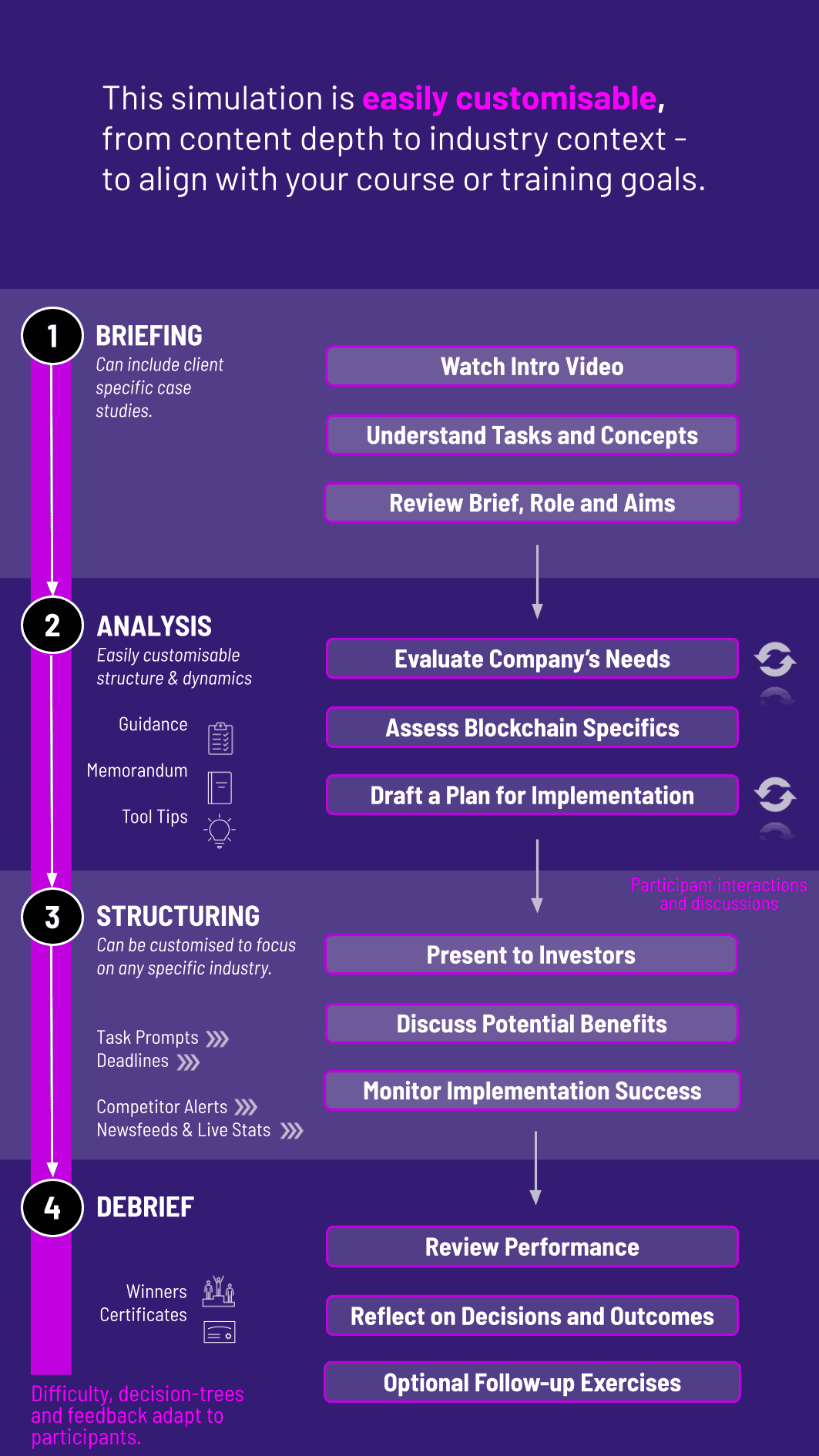
In this simulation, participants act as innovators, regulators, and investors navigating blockchain adoption - balancing decentralization, regulation & scalability while exploring real-world applications in finance, supply chains, and digital assets.
Blockchain fundamentals (distributed ledgers, smart contracts, consensus)
Cryptocurrency and digital asset markets
Tokenization of assets and liquidity innovation
Blockchain in supply chains and operations
Scalability and interoperability challenges
Cybersecurity and data integrity risks
Regulatory frameworks and compliance trade-offs
Governance models in decentralized systems
ESG and energy implications of blockchain adoption
Strategic opportunities for blockchain in traditional industries


Evaluate blockchain solutions for finance, operations, or supply chains
Weigh trade-offs between decentralization, scalability, and control
Navigate regulatory uncertainty and compliance pressures
Respond to external shocks like cyberattacks or market volatility
Pitch blockchain strategies to boards, investors, or regulators
Reflect on long-term adoption and innovation risks
By the end of the simulation, participants will be able to:
Understand core blockchain concepts and their applications
Evaluate blockchain solutions for different industries
Balance innovation with compliance and risk management
Recognize scalability, energy, and governance challenges
Apply blockchain to real-world business problems
Navigate uncertainty and volatility in blockchain markets
Communicate blockchain strategies persuasively to stakeholders
Collaborate across technical and leadership roles
Anticipate long-term implications of blockchain adoption
Build confidence in applying blockchain to strategic decision-making
The simulation’s flexible structure ensures that these objectives can be calibrated to match the depth, duration, and focus areas of each program, whether in higher education or corporate learning.
The simulation can be run individually or in teams, in classrooms or professional training programs. Each cycle represents a stage in blockchain adoption.
1. Receive a Scenario or Brief: Participants are introduced to a business or policy challenge involving blockchain adoption.
2. Analyse the Situation: They review market data, technical options, and regulatory updates to identify risks and opportunities.
3. Make Strategic Decisions: Participants decide whether to adopt, delay, or pivot blockchain strategies.
4. Collaborate Across Roles: Teams represent companies, regulators, or investors, negotiating strategies under different priorities.
5. Communicate Outcomes: Participants deliver strategy memos, board updates, or policy briefs.
6. Review and Reflect: Feedback highlights adoption success, risks mitigated, and stakeholder trust. Participants adapt strategies in later rounds.
Do participants need coding or technical skills? No. The simulation focuses on strategy, leadership, and decision-making around blockchain.
What industries are included? Finance, logistics, supply chains, healthcare, and more.
Can it be customized for executives? Yes. It’s designed for both business students and senior professionals.
Does it cover cryptocurrency? Yes. Scenarios include crypto trading, tokenization, and digital asset risks.
Is regulation part of the simulation? Yes. Participants face shifting compliance and governance requirements.
Can this run online? Yes. The simulation supports online, hybrid, and in-person formats.
How long does it run? It can be a 2-hour session or extended to multi-day workshops.
Does it address ESG concerns? Yes. Energy use and sustainability are included as decision factors.
Is it useful for strategy courses? Absolutely. It highlights blockchain’s impact on corporate and policy strategy.
How is performance measured? By innovation outcomes, risk management, and stakeholder trust.
Quality of blockchain strategy and adoption decisions
Responsiveness to new technologies and regulatory pressures
Creativity in applying blockchain to industry problems
Clarity and persuasiveness in communication
Collaboration and leadership under uncertainty
You can also include memo writing and debrief presentations as part of the assessment structure. Additionally, you can also add a built-in peer and self-assessment tool to see how participants rate themselves. This flexibility allows the simulation to be easily integrated by professors as graded courses at universities and by HR at assessment centres at companies.
Join this 20-minute webinar, followed by a Q&A session, to immerse yourself in the simulation.
or
Book a 15-minute Zoom demo with one of our experts to explore how the simulation can benefit you.